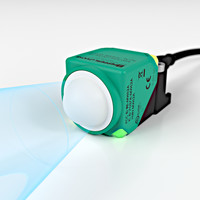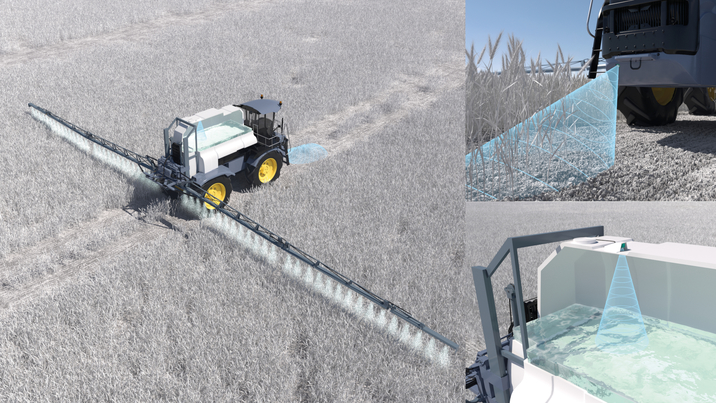Radar Sensors for Reliable Object Detection in Challenging Conditions
New Interface Available

Pepperl+Fuchs' radar sensors are now also available with a J1939 interface
The new industrial radar sensors from Pepperl+Fuchs provide reliable signals for object detection, velocity measurement, and collision protection. They are either equipped with CANopen or now also with CAN-J1939 interface, making them very easy to integrate. Due to their robust signaling, they are suitable for use in agricultural machinery and mobile equipment, including demanding conditions. The detection can be optimally adapted to the respective application: The devices make use of the fact that radar waves are reflected or partially penetrated by different materials to varying degrees.
Specific Measurement Modes

On this physical basis, the industrial radar sensors offer three different measurement modes:
- "Closest Distance" detects the object closest to the sensor, regardless of the material. For example, distance measurement reliably detects a wide variety of objects in the exit area of a vehicle.
- "Best Reflection" detects the object with the best reflection properties, whereas interfering objects are simply suppressed. For example, the sensor can measure the fill level of a tank through the plastic wall.
- "Fastest Velocity" uses velocity measurement to detect the object that moves towards or away from the sensor the fastest. This operating mode is used, for example, to monitor the travel path of automated guided vehicles (AGVs).
Methodological Stability
Radar waves are extremely resistant to interference such as rain, fog, wind, dust, and temperature fluctuations. Using the frequency-modulated continuous wave (FMCW) method, the industrial radar sensors reliably generate stable signals for comprehensive detection within the detection range. The hardware is housed in a very compact housing with IP68/69 degree of protection. The rotatable and tiltable sensor head can be aligned to the target area in virtually all installations. Additional accessories such as corner reflectors facilitate integration into various applications and also allow the detection of weakly reflective targets.
CAN Interfaces for Comprehensive Communication

CAN Open and J1939 interfaces as well as various connector options such as DEUTSCH and AMP Superseal enable easy integration of the radar sensors
Users can choose between sensor variants with CANopen and J1939 interfaces for transmitting the measured values and parameterization commands. This makes it very easy to integrate the devices into an existing CAN bus infrastructure without the need for complex individual wiring. In addition to the standardized M12 connector, fixed cables and special connectors such as DEUTSCH and AMP Superseal, which were primarily developed for vehicles, are also available for the electrical connection.
Optimized for Mobile Use
The measuring principle, hardware, and signal transmission are equally designed for robustness. This means that the industrial radar sensors are optimized for use in vehicles and mobile machines both indoors and outdoors. With their long range of up to more than 25 m, they detect an extensive area within the radius of action of vehicles or their booms. To cover multiple areas, several devices can be mounted in close proximity to each other. They do not interfere with each other's function.
Numerous Application Options

The radar sensors are used for velocity and environment monitoring in transport systems, crane booms and construction machinery, among other things. When used in agriculture, they have to withstand particularly harsh conditions. They serve many different purposes on agricultural machinery, such as speed measurement on seed drills, level measurement on field sprayers, or collision protection on harvesting machines.
The devices precisely measure the actual movement of the vehicles relative to the ground (speed over ground). Bumpy ground is reliably detected and interfering objects such as plants are suppressed. In spray agent tanks, the devices measure the fill level through the plastic tank wall and can also be easily retrofitted. The sensors therefore enable continuous monitoring of consumption to optimize the use of spraying agents. In intralogistics and merchandise management, the industrial radar sensors can perform similar control and safety tasks. They are used on vehicles and transport systems with and without drivers (forklift trucks, AGVs, AMRs).
Highlights of the Industrial Radar Sensors
- Distance and velocity measurement over more than 25 m
- Even in rain, fog, wind, or dust: reliable operation under extreme conditions
- Interference-free measurement of the target object through objects with a lower reflection amplitude
- Also suitable for particularly fast applications due to the sampling rate of up to 200 Hz
- Integrated CAN interface, vehicle-specific connectors, and extended EMC enable easy integration into mobile machines









 +212 (0) 661668548
+212 (0) 661668548